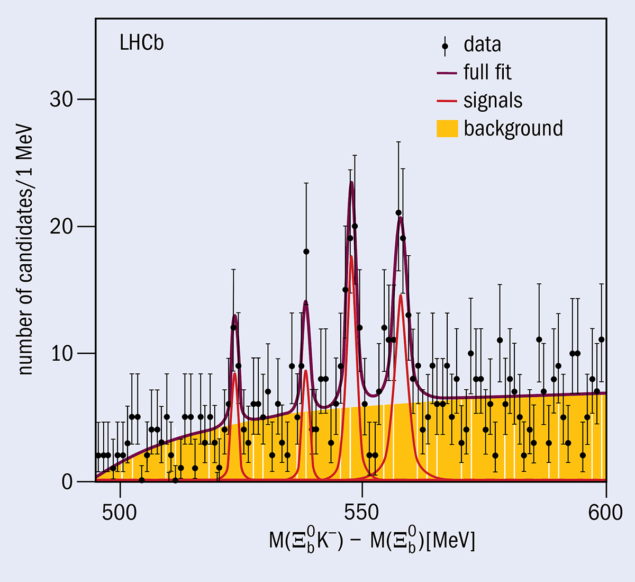A report from the LHCb experiment

The LHCb experiment has observed new beauty-baryon states, consistent with theoretical expectations for excited Ωb− (bss) baryons. The Ωb− (first observed a decade ago at the Tevatron) is a higher mass partner of the Ω− (sss), the 1964 discovery of which famously validated the quark model of hadrons. The new LHCb finding will help to test models of hadronic states, including some that predict exotic structures such as pentaquarks.
The LHCb collaboration has uncovered numerous new baryons and mesons during the past eight years, bringing a wealth of information to the field of hadron spectroscopy. Critical to the search for new hadrons is the unique capability of the experiment to trigger on fully hadronic beauty and charm decays of b baryons, distinguish protons, kaons and pions from one another using ring-imaging Cherenkov detectors, and reconstruct secondary and tertiary decay vertices with a silicon vertex detector.
LHCb physicists searched for excited Ωb− states via strong decays to Ξb0 K−, where the Ξb0 (bsu), in turn, decays weakly through Ξb0 → Ξc+ π− and Ξc+ → pK− π+. Using the full data sample collected during LHC Run 1 and Run 2, a very large and clean sample of about 19,000 Ξb0 signal decays was collected. Those Ξb0 candidates were then combined with a K− candidate coming from the same primary interaction. Combinations with the wrong sign (Ξb0 K+), where no Ωb− states are expected, were used to study the background. This control sample was used to tune particle-identification requirements to reject misidentified pions, reducing the background by a factor of 2.5 while keeping an efficiency of 85% on simulated signal decays.
The search used the difference in invariant mass, δM = M(Ξb0 K−) – M(Ξb0), determining the δM resolution to be approximately 0.7 MeV using simulated signal decays. (For comparison, the resolution is about 15 MeV for the Ξb0 decay.) Several peaks can be seen by eye (see figure), but to measure their properties a fit is needed. To help constrain the background shape, the wrong-sign δM spectrum (not shown) is fitted simultaneously with the signal mode. The peaks are each described by a relativistic Breit-Wigner convolved with a resolution function.
The width of the Ωb(6350)− shows the most significant deviation from zero
Four peaks, corresponding to four excited Ωb− states, were included in the fit. Following the usual convention, the new states were named according to their approximate mass: Ωb(6316)−, Ωb(6330)−, Ωb(6340)− and Ωb(6350)−. Each mass was measured with a precision of well below 1 MeV, and the errors are dominated by the uncertainty on the world-average Ξb0 mass. All four peaks are narrow. The width of the Ωb(6350)− shows the most significant deviation from zero, with a central value of 1.4+1.0 -0.8 ± 0.1 MeV. The two lower-mass peaks have significances below three standard deviations (2.1σ and 2.6σ) and so are not considered conclusive observations. But the two higher-mass peaks have significances of 6.7σ and 6.2σ, above the 5σ threshold for discovery.
The new states seen by LHCb follow a similar pattern to the five narrow peaks observed in the Ξc+K− invariant mass spectrum by the collaboration in 2017. It has proven difficult to obtain a satisfactory explanation of all five as excited Ωc0(css) states, raising the possibility that at least one of the Ξc+ K− peaks is a pentaquark or a molecular state. Since the Ξc+ K−and Ξb0 K− final states differ only by replacing a c quark with a b quark, the two analyses together should provide strong constraints on any models that aim to explain the structures in these mass spectra.





